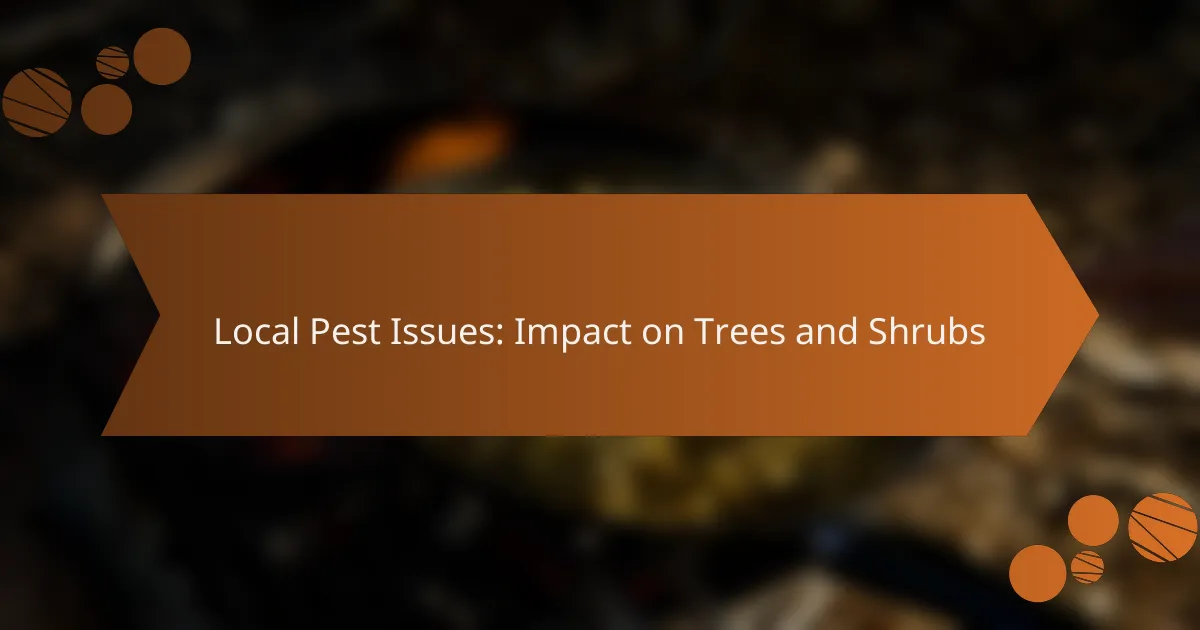Local pest issues pose a significant threat to the health and vitality of trees and shrubs in urban settings, often resulting in weakened plants and diminished biodiversity. Understanding the impact of these pests is essential for property owners and city planners, as urban environments can create ideal conditions for infestations. Early identification of signs such as leaf damage or wilting is crucial for effective management and preservation of green spaces.
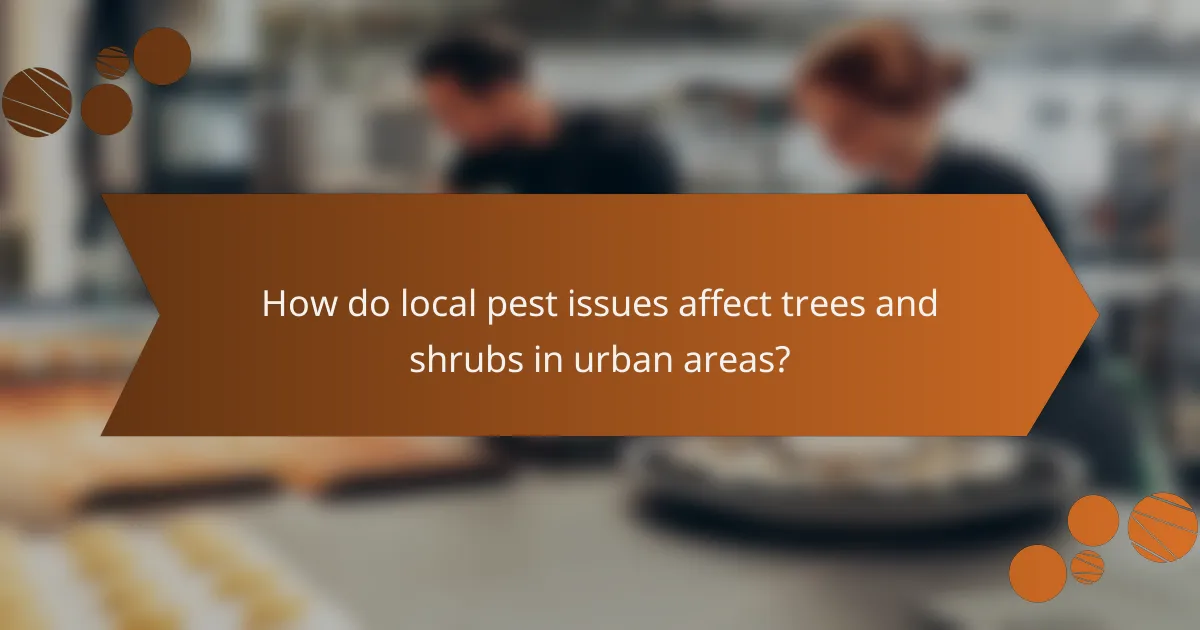
How do local pest issues affect trees and shrubs in urban areas?
Local pest issues can significantly impact the health and growth of trees and shrubs in urban areas, leading to weakened plants and decreased biodiversity. Urban environments often provide ideal conditions for pests, making it crucial for property owners and city planners to understand these effects.
Impact on growth and health
Pests can hinder the growth of trees and shrubs by damaging leaves, stems, and roots, which are essential for nutrient uptake and photosynthesis. This damage can lead to stunted growth, reduced flowering, and increased susceptibility to diseases. Over time, infested plants may die if not adequately managed.
Healthy trees and shrubs contribute to urban ecosystems by providing shade, improving air quality, and supporting wildlife. When pests compromise plant health, these benefits diminish, affecting the overall environment and quality of life in urban settings.
Common pests in urban environments
Common pests affecting trees and shrubs in urban areas include aphids, spider mites, and scale insects. These pests thrive in the warmer microclimates created by buildings and pavement, making them prevalent in city landscapes. Additionally, invasive species like the emerald ash borer can devastate entire populations of specific trees.
Understanding which pests are common in your area can help in early detection and management. Local extension services or pest management professionals can provide guidance on identifying and addressing these threats effectively.
Symptoms of pest damage
Symptoms of pest damage vary depending on the type of pest but often include discolored leaves, wilting, and unusual growth patterns. For instance, aphid infestations may lead to curled leaves and sticky residue on surfaces, while spider mites can cause fine webbing and speckled foliage.
Regularly inspecting trees and shrubs for these signs can help catch infestations early. Property owners should look for changes in plant appearance and health, as prompt action can prevent further damage and preserve urban greenery.
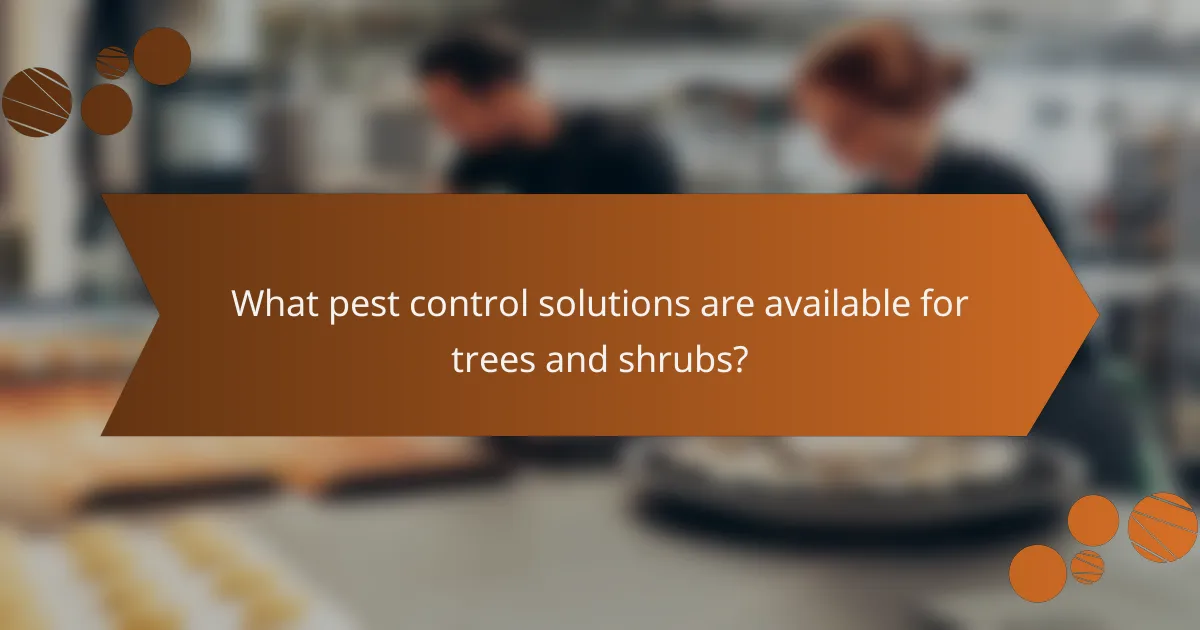
What pest control solutions are available for trees and shrubs?
Pest control solutions for trees and shrubs include a variety of methods aimed at managing and mitigating pest infestations. These solutions range from integrated pest management strategies to organic and chemical treatments, each with its own benefits and considerations.
Integrated Pest Management (IPM)
Integrated Pest Management (IPM) is a holistic approach that combines multiple strategies to control pests while minimizing risks to people and the environment. It involves monitoring pest populations, identifying thresholds for action, and using a mix of biological, cultural, mechanical, and chemical methods.
Key components of IPM include regular inspections of trees and shrubs, understanding pest life cycles, and applying control measures only when necessary. This method not only reduces pesticide use but also promotes long-term sustainability in managing pest issues.
Organic pest control methods
Organic pest control methods focus on using natural substances to deter or eliminate pests without synthetic chemicals. Common organic solutions include neem oil, insecticidal soaps, and diatomaceous earth, which can be effective against a range of pests while being safer for beneficial insects and the environment.
When using organic methods, it’s essential to apply them at the right time, such as during early pest activity, to achieve the best results. Additionally, maintaining healthy soil and plant conditions can enhance the effectiveness of these organic treatments.
Chemical treatments and their safety
Chemical treatments for pest control can be effective but require careful consideration of safety and environmental impact. Many chemical pesticides are regulated and should be used according to label instructions to ensure they do not harm non-target species or the surrounding ecosystem.
Before applying chemical treatments, assess the specific pest problem and consider factors such as the type of trees or shrubs affected, the life cycle of the pests, and potential risks to humans and pets. Always wear protective gear and follow local regulations regarding pesticide use to ensure safe application.
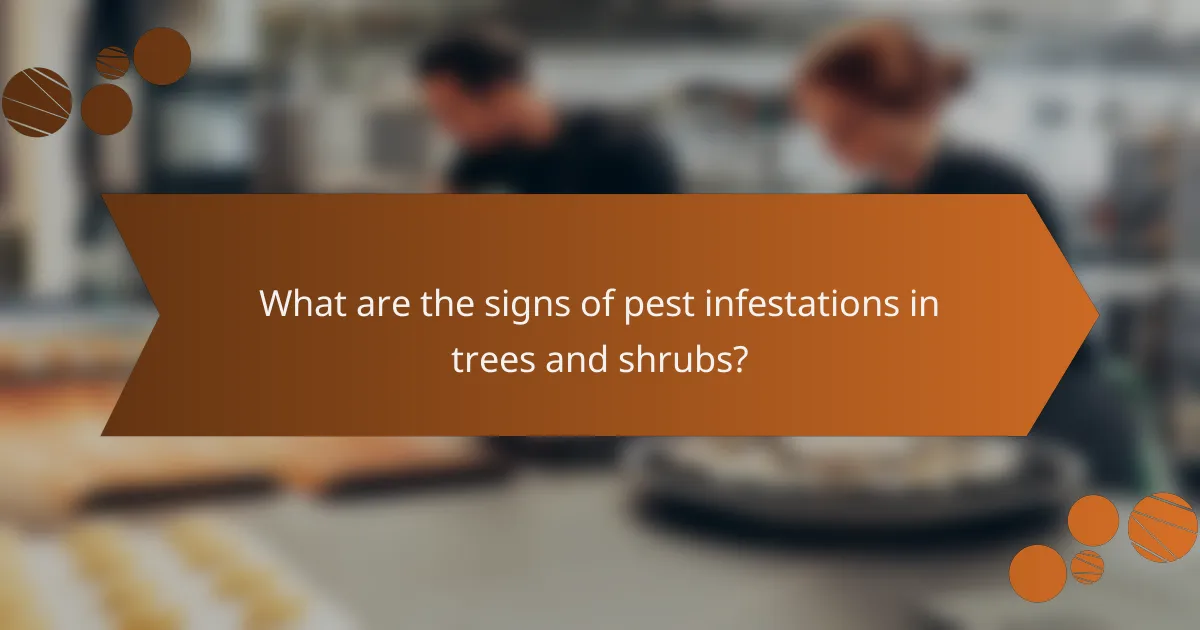
What are the signs of pest infestations in trees and shrubs?
Signs of pest infestations in trees and shrubs include visible damage, such as holes in leaves or bark, and changes in plant behavior, like wilting or stunted growth. Identifying these indicators early can help in managing infestations effectively.
Visible damage indicators
Visible damage indicators are often the first signs of pest infestations. Look for holes in leaves, frass (insect droppings), or discolored foliage. Bark may show signs of peeling or tunneling, which can indicate the presence of borers.
In addition to these signs, wilting or browning leaf edges can suggest stress from pests. Regularly inspecting your plants can help catch these issues early, allowing for timely intervention.
Behavioral changes in plants
Behavioral changes in plants can also signal pest problems. For instance, if a plant is suddenly dropping leaves or exhibiting stunted growth, pests may be affecting its health. These changes can occur due to the plant’s resources being diverted to combat pests.
Another behavioral change to watch for is an increase in sap production, which can indicate stress from sap-sucking insects like aphids. Monitoring these changes can provide crucial insights into the health of your trees and shrubs.
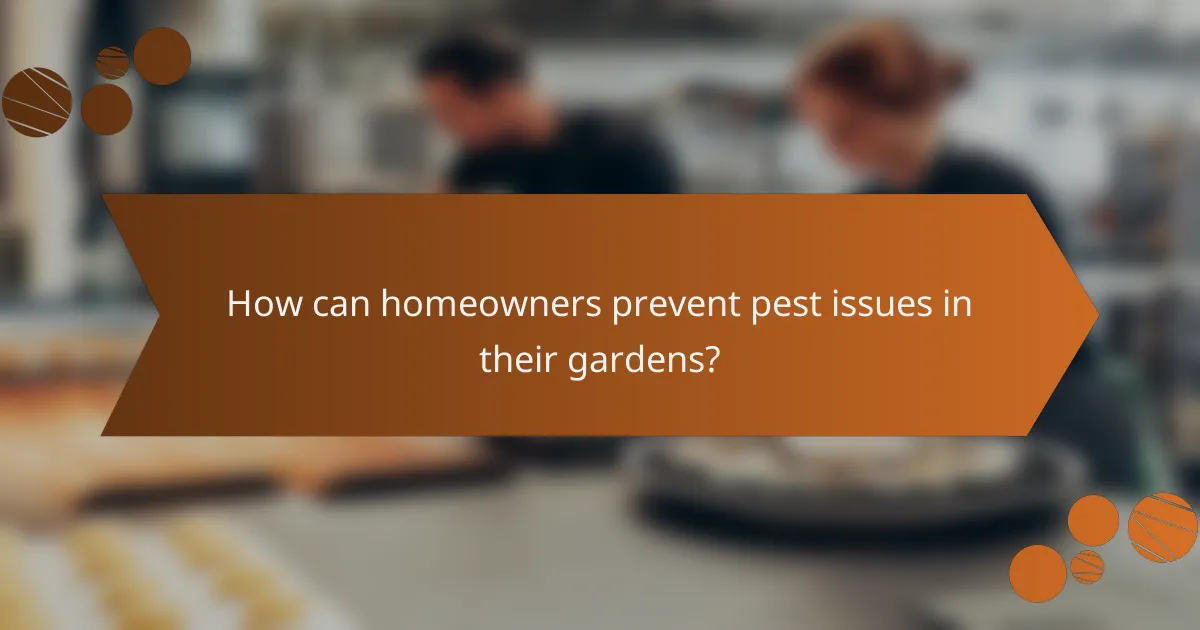
How can homeowners prevent pest issues in their gardens?
Homeowners can prevent pest issues in their gardens by implementing regular maintenance and selecting pest-resistant plant varieties. These proactive measures help to create a healthy environment for plants while minimizing the risk of pest infestations.
Regular maintenance practices
Regular maintenance practices are essential for keeping gardens healthy and pest-free. This includes tasks such as pruning, weeding, and monitoring plants for early signs of pest activity. By routinely inspecting plants, homeowners can catch potential issues before they escalate.
Additionally, maintaining proper watering and fertilization schedules can strengthen plants, making them less susceptible to pests. For instance, overwatering can lead to root rot, which attracts pests. Aim to water deeply but infrequently to promote strong root systems.
Choosing resistant plant varieties
Selecting resistant plant varieties is a strategic way to reduce pest problems in gardens. Many nurseries offer plants that have been bred for pest resistance, which can significantly lower the likelihood of infestations. Researching local pest issues can help homeowners choose the right varieties for their specific region.
For example, certain types of roses are known to resist common pests like aphids and spider mites. Homeowners should consider native plants as they are often more resilient to local pests and diseases. Incorporating these varieties can lead to a more sustainable and low-maintenance garden.
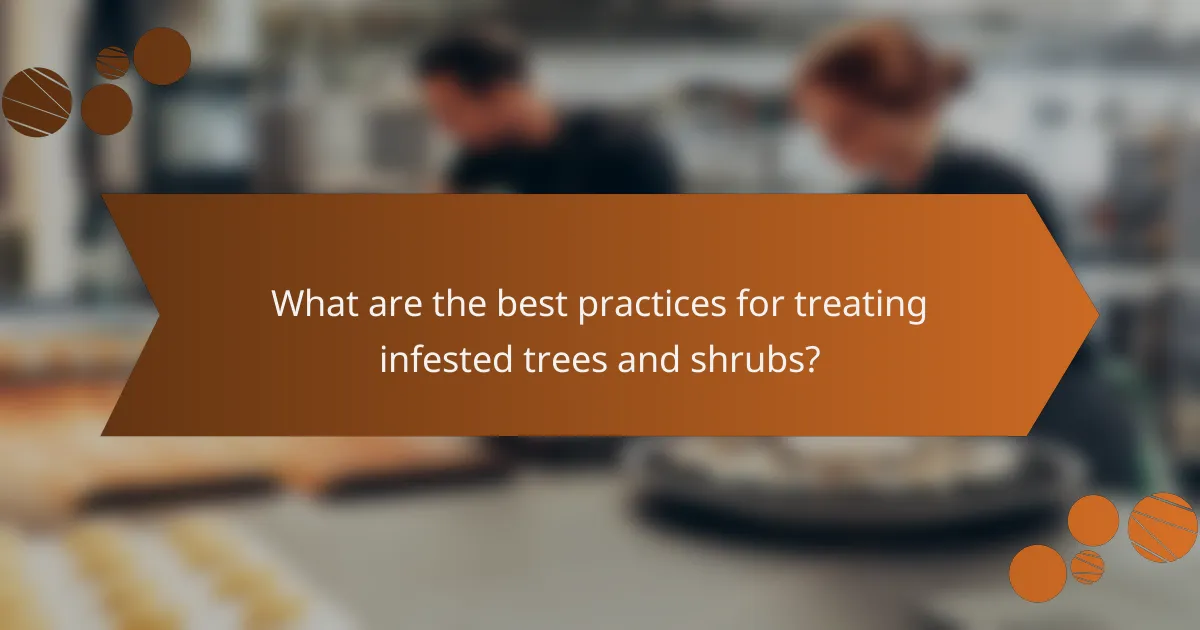
What are the best practices for treating infested trees and shrubs?
Effective treatment of infested trees and shrubs involves a combination of monitoring, proper identification of pests, and timely intervention. Implementing these best practices can help restore plant health and prevent further damage.
Step-by-step treatment process
Begin by inspecting the affected trees and shrubs to identify the specific pests causing the infestation. Look for signs such as discolored leaves, webbing, or visible insects. Once identified, choose an appropriate treatment method, which may include insecticidal soaps, horticultural oils, or systemic insecticides.
Next, apply the chosen treatment according to the manufacturer’s instructions, ensuring even coverage on all affected areas. Repeat applications may be necessary, especially for persistent pests. Regularly monitor the plants after treatment to assess effectiveness and make adjustments as needed.
When to call a professional service
Consider contacting a professional pest control service if the infestation is severe or if you are unsure about the pest identification. Professionals have access to specialized treatments and equipment that can effectively manage larger infestations.
If your trees or shrubs are valuable or if you are dealing with invasive species, professional help can ensure the best outcome. Additionally, if the health of the plant is declining rapidly, expert intervention may be necessary to save it.

What are the local regulations regarding pest control in gardens?
Local regulations for pest control in gardens typically require adherence to specific guidelines for pesticide use, including obtaining necessary permits and considering environmental impacts. These regulations aim to protect public health, wildlife, and the ecosystem while managing pest populations effectively.
Permits for pesticide use
In many regions, gardeners must obtain permits before applying certain pesticides, especially those classified as restricted-use. These permits often involve submitting an application that details the intended use, the type of pesticide, and the area of application.
It is crucial to check with local agricultural or environmental agencies to understand the specific requirements, as they can vary significantly. Failing to secure the proper permits can result in fines or restrictions on future pesticide use.
Environmental considerations
When managing pests in gardens, environmental considerations are paramount. Many regulations emphasize the need to minimize harm to beneficial insects, birds, and aquatic ecosystems. This may include guidelines on buffer zones where pesticides cannot be applied.
Gardeners should consider using integrated pest management (IPM) strategies, which focus on combining biological, cultural, and mechanical controls with chemical methods. This approach not only complies with regulations but also promotes a healthier garden ecosystem.
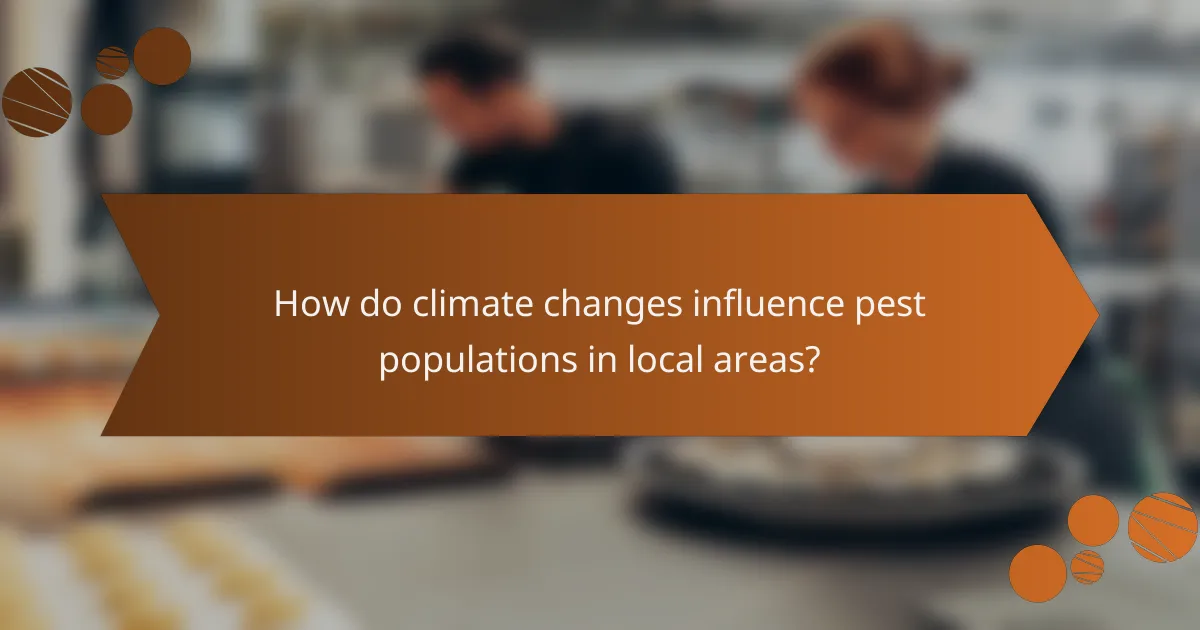
How do climate changes influence pest populations in local areas?
Climate changes significantly affect pest populations by altering their habitats, reproduction rates, and food availability. Warmer temperatures and shifting precipitation patterns can lead to increased pest outbreaks, impacting local trees and shrubs.
Temperature Effects on Pest Life Cycles
Rising temperatures can accelerate the life cycles of many pests, allowing them to reproduce more frequently throughout the growing season. For instance, species like aphids and beetles may experience multiple generations in a single year, leading to higher population densities.
Additionally, milder winters can result in more pests surviving the cold months, which can lead to earlier infestations in spring. This shift can stress local flora, as trees and shrubs may not be prepared for the sudden increase in pest activity.
Impact of Precipitation Changes
Changes in precipitation patterns can influence pest populations by affecting their food sources and habitats. For example, increased rainfall can promote the growth of fungi and other organisms that pests rely on for sustenance, leading to population booms.
Conversely, drought conditions can weaken trees and shrubs, making them more susceptible to pest infestations. Stressed plants are less able to defend themselves, which can result in more severe damage from pests.
Geographic Distribution Shifts
Climate change can cause pests to expand their geographic ranges, moving into areas where they were previously uncommon or absent. This shift can introduce new pest species to local ecosystems, potentially disrupting existing plant communities.
For example, warmer climates may allow certain invasive pests to thrive in regions that were once too cold for them. Homeowners and land managers should monitor for these newcomers and take proactive measures to protect their trees and shrubs.
Management Strategies for Local Pests
To mitigate the impact of climate-driven pest populations, consider implementing integrated pest management (IPM) strategies. This involves monitoring pest levels, using biological controls, and applying pesticides judiciously when necessary.
Regularly inspect trees and shrubs for signs of pest damage and take action early to prevent infestations from escalating. Employing native plants can also enhance resilience, as these species are often better adapted to local pest pressures.
